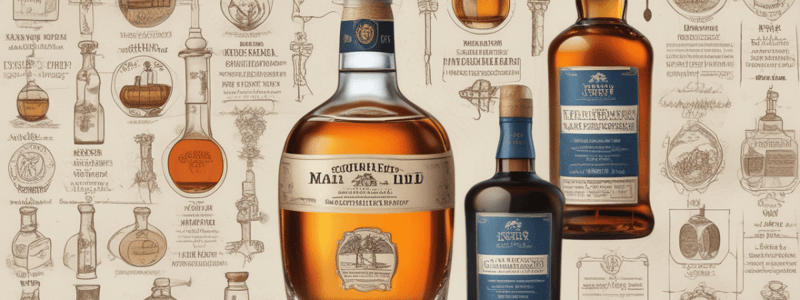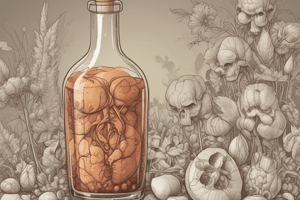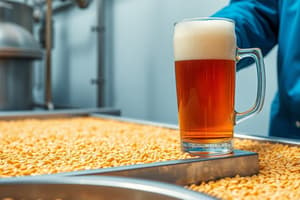Podcast
Questions and Answers
Which of the following is NOT a characteristic of Lowland malt whiskies?
Which of the following is NOT a characteristic of Lowland malt whiskies?
- Heavily peated and smoky (correct)
- Subtle hints of fruit and flowers
- Light and smooth flavors
- Typically have a light body
Which of the following is a key step in the production of malt whisky?
Which of the following is a key step in the production of malt whisky?
- Blending with grain whisky
- Distillation in copper pot stills (correct)
- Fermentation using baker's yeast
- Aging in stainless steel tanks
Which Scottish whisky region is known for its sweet, fruity, and gently smoky malt whiskies?
Which Scottish whisky region is known for its sweet, fruity, and gently smoky malt whiskies?
- Lowlands
- Islay
- Speyside (correct)
- Highlands & Islands
Which of the following is a notable characteristic of malt whiskies from the Highlands & Islands region?
Which of the following is a notable characteristic of malt whiskies from the Highlands & Islands region?
What is the purpose of the mashing process in malt whisky production?
What is the purpose of the mashing process in malt whisky production?
Which of the following is NOT a key step in the production of malt whisky?
Which of the following is NOT a key step in the production of malt whisky?
Which of the following is a characteristic of Islay malt whiskies, which are not mentioned in the text?
Which of the following is a characteristic of Islay malt whiskies, which are not mentioned in the text?
What is the purpose of the double distillation process in malt whisky production?
What is the purpose of the double distillation process in malt whisky production?
Which of the following is NOT a characteristic of Speyside malt whiskies?
Which of the following is NOT a characteristic of Speyside malt whiskies?
What is the role of oak casks in the maturation of malt whisky?
What is the role of oak casks in the maturation of malt whisky?
Which of the following is NOT a characteristic of Campbeltown malts according to the text?
Which of the following is NOT a characteristic of Campbeltown malts according to the text?
What is the primary purpose of the malting process described in the text?
What is the primary purpose of the malting process described in the text?
What is the main purpose of the 'cooking' stage in the production process?
What is the main purpose of the 'cooking' stage in the production process?
What is the primary function of the 'wash still' in the distillation process?
What is the primary function of the 'wash still' in the distillation process?
Which of the following is NOT a key factor that contributes to the unique taste profiles of Scotch whiskies according to the text?
Which of the following is NOT a key factor that contributes to the unique taste profiles of Scotch whiskies according to the text?
What is the main purpose of the 'spirit still' or 'tall still' in the distillation process?
What is the main purpose of the 'spirit still' or 'tall still' in the distillation process?
Which of the following is NOT a key step in the production process of malt whisky according to the text?
Which of the following is NOT a key step in the production process of malt whisky according to the text?
What is the primary purpose of the fermentation stage in the production process?
What is the primary purpose of the fermentation stage in the production process?
Which of the following is NOT a characteristic of Islay malts according to the text?
Which of the following is NOT a characteristic of Islay malts according to the text?
What is the primary purpose of the maturation and blending stage in the production process?
What is the primary purpose of the maturation and blending stage in the production process?
What is the main feature of Bordeaux wines that makes them famous worldwide?
What is the main feature of Bordeaux wines that makes them famous worldwide?
What type of climate does the Bordeaux wine region generally have?
What type of climate does the Bordeaux wine region generally have?
Which of the following areas is NOT part of the Bordeaux wine region?
Which of the following areas is NOT part of the Bordeaux wine region?
Which grape variety is NOT commonly used in producing red wines in the Bordeaux region?
Which grape variety is NOT commonly used in producing red wines in the Bordeaux region?
What traditional method of winemaking is mentioned in the text as being used by Bordeaux wineries for centuries?
What traditional method of winemaking is mentioned in the text as being used by Bordeaux wineries for centuries?
Which of the following soil characteristics does NOT contribute to the unique characteristics of Bordeaux wines?
Which of the following soil characteristics does NOT contribute to the unique characteristics of Bordeaux wines?
Which white grape variety is primarily used in producing sweet white wines in the Bordeaux region?
Which white grape variety is primarily used in producing sweet white wines in the Bordeaux region?
What makes each area within the Bordeaux region unique when it comes to winemaking?
What makes each area within the Bordeaux region unique when it comes to winemaking?
What role do modern techniques, such as temperature control during fermentation and selective use of newer oak barrels, play in winemaking according to the text?
What role do modern techniques, such as temperature control during fermentation and selective use of newer oak barrels, play in winemaking according to the text?
What year was the Bordeaux wine classification system established?
What year was the Bordeaux wine classification system established?
What factor can cause châteaus in Bordeaux to move up or down in the classification system over time?
What factor can cause châteaus in Bordeaux to move up or down in the classification system over time?
What geographical aspects contribute to Bordeaux wines' renowned reputation?
What geographical aspects contribute to Bordeaux wines' renowned reputation?
In Bordeaux, what category does 'Premier Cru Classe A and Premier Grand Cru Classe B' fall under in the wine classification system?
In Bordeaux, what category does 'Premier Cru Classe A and Premier Grand Cru Classe B' fall under in the wine classification system?
What aspect distinguishes Bordeaux wines from dry reds to sweet whites for wine enthusiasts to explore?
What aspect distinguishes Bordeaux wines from dry reds to sweet whites for wine enthusiasts to explore?
How do technological advancements in winemaking impact the final product of Bordeaux wines?
How do technological advancements in winemaking impact the final product of Bordeaux wines?
What is the primary determinant for ranking Bordeaux wines according to their quality?
What is the primary determinant for ranking Bordeaux wines according to their quality?
Flashcards are hidden until you start studying
Study Notes
Malt Whisky: A Comprehensive Guide
Malt whisky is one of two main categories of Scotch whisky, the other being grain whisky. It is made from malted barley that has been germinated, dried, and mashed with hot water. This process releases enzymes which convert starches into fermentable sugars. The resulting liquid, called wort, is then distilled twice in copper stills before being aged in oak casks. In this article, we will explore the various regions where malt whisky is produced and the intricate process involved in creating these beloved spirits.
Regions of Production
Scotland's whisky industry is divided into five distinct geographical regions, each boasting its unique characteristics and flavor profiles:
-
Lowlands: Known for their light, smooth flavors, Lowland malts typically have subtle hints of fruit and flowers. Notable examples include Auchentoshan Three Wood, Glengoyne 12 Year Old, and Glenkinchie 12 Year Old.
-
Highlands & Islands: These areas produce a wide range of styles, from peaty and smoky to floral and fruity. Some popular Highland malts include Dalmore Gran Reserva, Laphroaig Quarter Cask, and Oban 14 Year Old.
-
Speyside: Often considered the heart of Scottish whisky, Speyside malts are known for their sweetness, fruitiness, and gentle smoke. Famous brands like The Glenlivet, Balvenie, and Macallan call this region home.
-
Campbeltown: Located on Scotland's west coast, Campbeltown malts are characterized by their full-bodied flavors and rich, smoky characteristics. Examples include Springbank, Longrow, and Hazelburn.
-
Islay: Renowned for its heavily peated whiskies, Islay malts often exhibit strong notes of seaweed, medicinal tar, and dried fruit. Iconic offerings from this region include Ardbeg Uigeadail, Lagavulin Distillery Edition, and Laphroaig Select.
Each region's climate, geography, and traditional practices contribute to the unique taste profiles found within Scotch whiskies.
Production Process
The creation of malt whisky involves several steps, each carefully controlled to ensure the desired outcome:
Malting
Firstly, barley is soaked in water for around 40 hours to encourage it to start sprouting. Once it has sprouted, the grains are spread out on the floor to dry naturally using ambient air currents. As they dry, the soft layers inside the grain break down, releasing sugary compounds that give whisky its characteristic flavors.
Milling
Once the malted barley is ready, it is transported to a mill where it is crushed into small particles called 'grist'. The consistency of the grist determines how quickly the heat can be released during the next stage - cooking.
Cooking
Next, the grist is mixed with hot water in a series of tanks known as washbacks. Enzymes present in the malted barley transform starches into fermentable sugar, forming a mixture known as 'wort'. This process also introduces heat, causing the soluble proteins to coagulate into particles visible to the naked eye.
Fermentation
Yeast is added to the warm wort in the washbacks, initiating a biological process where yeast consumes the available sugars and produces alcohol and carbon dioxide gas. The alcohol concentration increases over three days until the yeast dies off from lack of nutrients.
Distillation
After fermentation, the liquid is transferred to a 'wash still', where it is heated to create vapour. The vapor rises through the still and condenses back into a liquid, separating the alcohol from the remaining impurities such as acids, esters, and higher alcohols. The resulting product is called low-wine.
This first distillation is followed by another round in a second still, known as a spirit still or tall still. This second distillation refines the spirit further, concentrating the alcohol while removing even more impurities. The final product is called new make spirit.
Maturation & Blending
Finally, the new make spirit is transferred to oak casks, where it will mature for several years. During this period, the spirit interacts with the wood, absorbing various flavors and aromas while losing some alcohol content through evaporation. Once matured to the desired age, the spirit may be bottled as a single malt or blended with other whiskies to create a unique taste profile.
In conclusion, malt whisky is a complex and fascinating product, steeped in history and tradition. From the diverse regions of Scotland to the intricate production processes, each step plays a crucial role in creating the diverse range of flavors we enjoy today.
Studying That Suits You
Use AI to generate personalized quizzes and flashcards to suit your learning preferences.




